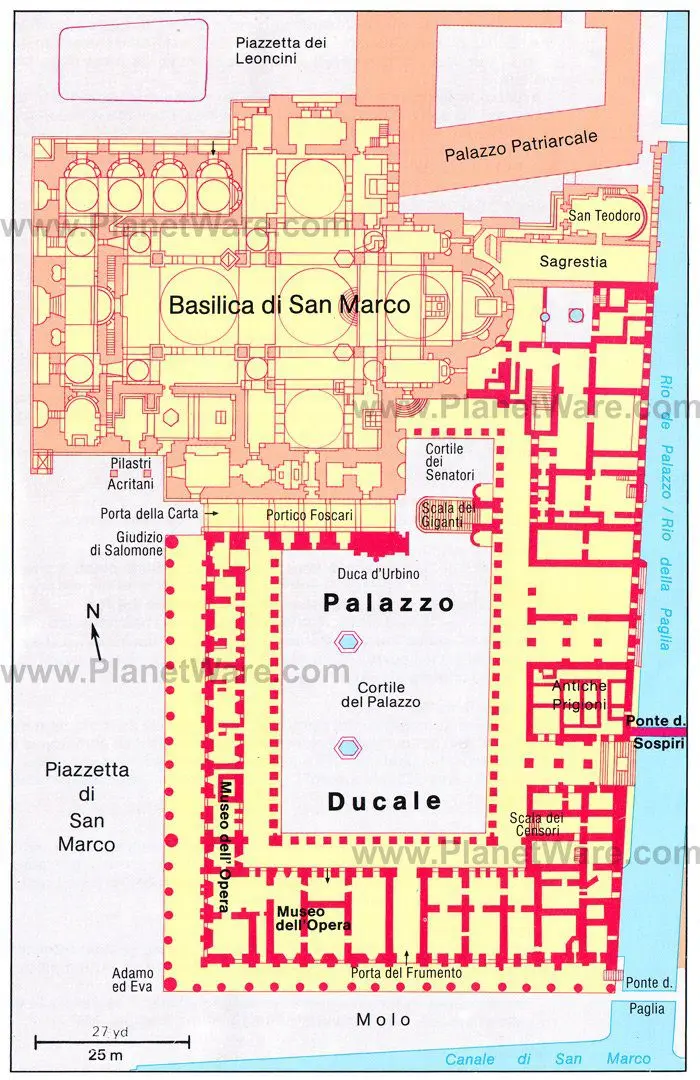Contents
- Façade and Exterior
- Porta della Carta
- Bridge of Sighs
- Foscari Arch and Scala dei Giganti
- Tours of the Interior
- Sala del Maggior Consiglio
- Scala d’Oro
- Sala del Collegio and Sala del Senato
- Sala del Consiglio dei Dieci
- Doge’s Palace Apartments
- Prigioni (Prisons)
- Armory
- Where to Stay near the Doge’s Palace
- Tips and Tactics: How to Make the Most of Your Visit to the Doge’s Palace
- Getting to the Doge’s Palace
- Address
One of Europe’s most beautiful and easily recognizable buildings, the Doge’s Palace (Palazzo Ducale) was not only the center of government during the Venetian Republic but also the residence of the Doge. The palace for the first of these powerful leaders was a wretched, gloomy wooden fortress with massive defensive towers, and after several fires, the castle was converted into a Byzantine-style palace.
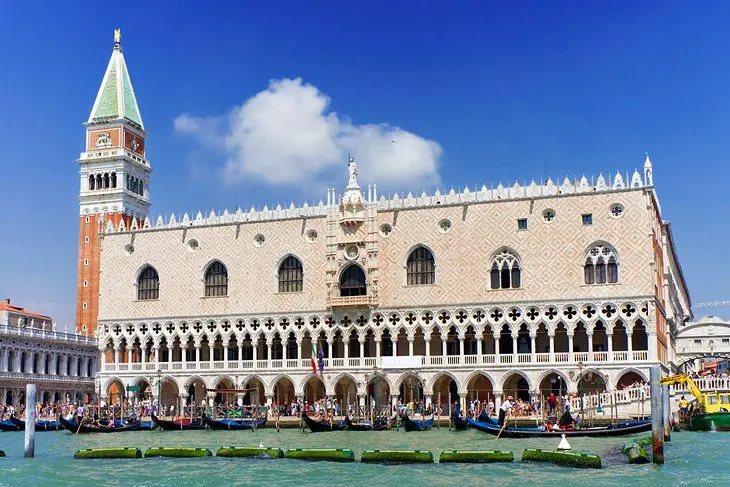
The one you see today was built mainly in the 14th century, and the façade overlooking the Piazzetta dates from the first half of the 15th century. Although the palace is now a museum, unlike most museums, these paintings were created especially to decorate the Doge’s Palace, not added later.
The artworks, iconic beauty, and interesting history of the Doge’s Palace make it one of Venice’s major attractions for tourists. You’ll be sure of seeing all the highlights with this visitor’s guide to exploring the Doge’s Palace.
See also: Where to Stay near the Doge’s Palace
Façade and Exterior
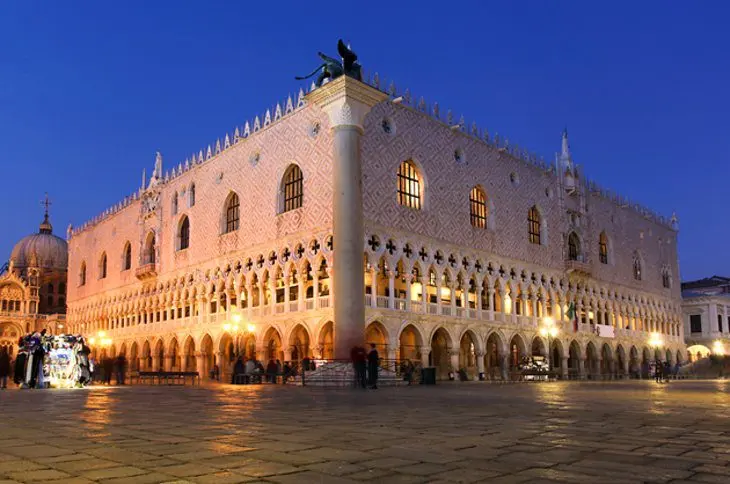
The distinctive look of this masterpiece of Gothic architecture stems from the way its designers managed to suspend the enormous solid bulk of the palace upon a double arcade of slender, almost delicate Istrian marble columns. They achieved that visual balance by creating a remarkably light-looking upper story, its surface made to appear almost lacy with patterns of pink Verona marble, pierced by graceful arching windows.
The effect is nothing short of enchanting and is enhanced by a cornice of merlons and spires that seem to make the palace waft airily into the sky. The façade is sometimes seen as a metaphor for the city itself, its enormous weight supported by a foundation of wooden piles driven into the floor of the lagoon.
Be sure to step back and admire the façade as a whole work of art, but don’t overlook the individual columns, their beautiful carved capitals, and the sculptures that decorate the façades overlooking the Grand Canal and the Piazzetta. A reminder of the palace’s grimmer past – you’ll find many more inside – are the two columns (the ninth and 10th) made of red marble, between which death sentences were once pronounced.
Porta della Carta
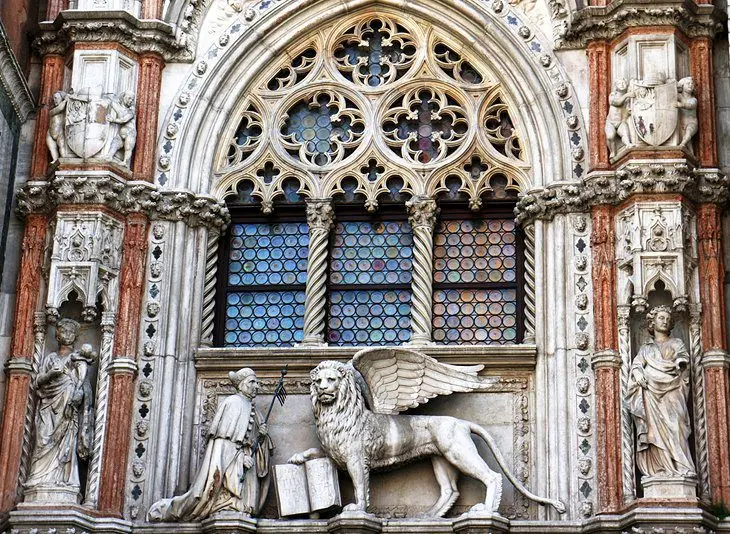
The Porta della Carta, the palace’s main entrance, is the link between the Doge’s Palace and St. Mark’s Basilica, created by the brothers Giovanni and Bartolomeo Bon in the mid-1400s. It is considered one of the two most perfect examples of Venetian Gothic (the other is the Ca’ d’Oro). All around it are carved ornamental and allegorical figures, and above is Doge Francesco Foscari kneeling before the Lion of St. Mark.
The symbolism is strong here, showing that in the Venetian Republic, the individual bowed to the power of the state. The present sculpture is a 19th-century copy of the original, which was destroyed when Napoleon’s army invaded Venice in 1797. The name Porta della Carta means Paper Gate and is thought to have come from those who waited here to hand their petitions to members of the Council. The stump of a column beside the gate was used as a podium for proclaiming laws of the Republic.
Bridge of Sighs
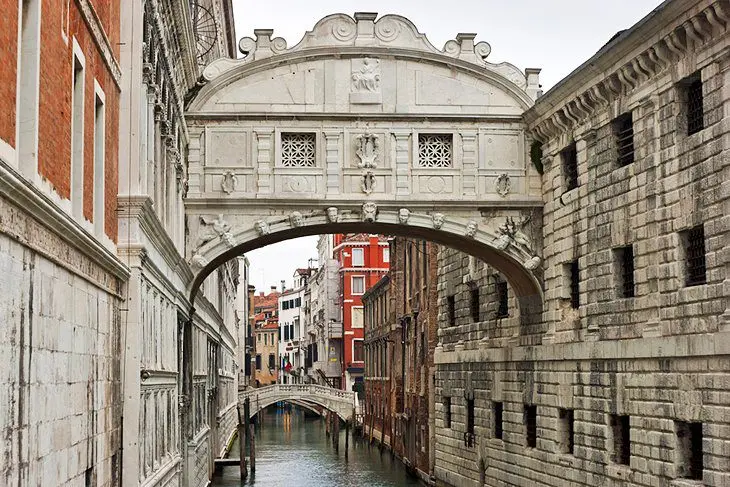
If you haven’t already seen it, before you enter the palace for a tour, walk to the end of the façade on the Grand Canal side for a look at one of the most famed of all Venetian icons, Ponte dei Sospiri – the Bridge of Sighs.
The graceful curve and delicate stone tracery of the enclosed Baroque arch bridge connecting the Doge’s Palace with the first floor of the prison belies its grim story. It was through the stone grillwork of this bridge that prisoners caught their last glimpse of Venice as they were taken before the judges for sentencing, thence to prison or worse. The sentences given by Venetian judges were known to be as unmerciful as the laws of the Republic.
Foscari Arch and Scala dei Giganti
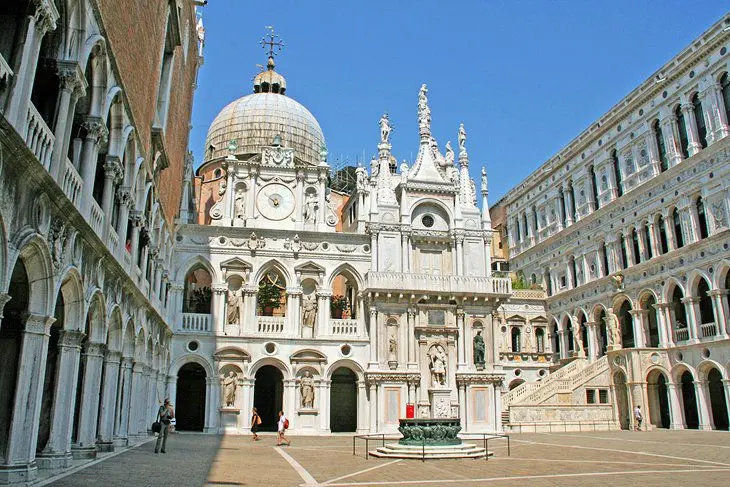
The Porta della Carta leads into the large central courtyard, through the Foscari Arch. Although clearly Gothic, rich ornamentations of columns, niches, and turrets already show Renaissance influences, especially the statues of Adam and Eve sculpted by Antonio Rizzo.
He also designed the Scala dei Giganti, Staircase of the Giants, which adjoins the arch and leads up to the State Apartments on the upper floor. At its top landing, the Doges were crowned – or in the case of Doge Marino Faliero, beheaded. The staircase is named not for its own grand dimensions, but for the two larger-than-life figures of Mars and Neptune by Jacopo Sansovino, created in 1567 and symbolizing Venice’s power on land and sea.
To the left of the staircase is the place where the senators used to gather, Cortile dei Senatori, with a Late Renaissance front and beautiful marble ornamentation. From the courtyard, you can see that although it looks like a square building, the palace actually has only three wings, with the fourth side formed by the adjoining Basilica di San Marco (St. Mark’s Basilica). The courtyard, largely designed by Antonio Rizzo after a fire in 1483, is a Renaissance masterpiece.
Tours of the Interior
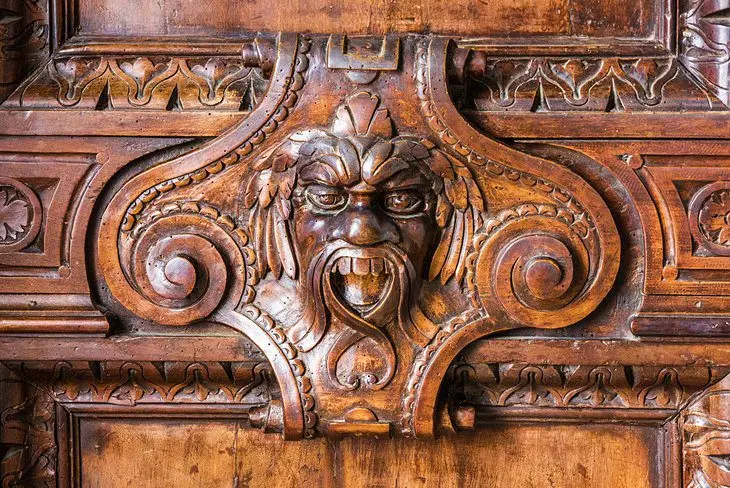
While the exterior and courtyard of the Doge’s Palace are impressive architectural landmarks and icons of Venice, you really must see the spectacular halls and staircases that lie inside its walls. There are several ways.
You can get a St. Mark’s Square Museums ticket, which includes several other museums around the square but is unguided and often means joining the long lines waiting for entrance. Or you can see it as part of the 2 ¼-hour Skip The Line: St. Mark’s Basilica and Doge’s Palace Tour , which saves standing in line here or at the basilica and includes a guide who will point out the most important highlights and history.
While a general admission or combined tour allows you to see the Sala del Maggior Consiglio, Scala Ord’o, Sala del Collegio, and Sala del Senato, several other fascinating places to visit in the Doge’s Palace are only open to guided tours. Not included in the general admission are the Chamber of the Three Heads of the Council of Ten; Inquisitors Hall; and the Stanza della Tortura, where confessions were forced from prisoners as the judges watched.
Nor are the Piombi, the most dreaded of all the prison cells under the lead roof, where Giacomo Casanova was imprisoned until his legendary escape. You can reserve a guided Secret Itineraries Tour that includes these, or the in-depth Skip the Line: Doge’s Palace Ticket and Tour , a two-hour immersion with a guide (and headphones, so you can hear every word) to this fascinating palace. In addition to bypassing the lines and seeing the rooms that are usually open to tourists, you will see inquisition chambers described above, private apartments, and cross the Bridge of Sighs to tour the lower cells and the Piombi, including Casanova’s cell.
Official site: http://palazzoducale.visitmuve.it/en
Sala del Maggior Consiglio

This Hall of the Great Council, built between 1340 and 1355, was the seat of the lower house of the Venetian Parliament. It is impressive both for its immensity (54 meters by 25 meters) and because its harmonious proportions keep it from being overwhelming. Its size was a matter of practicality: when the council was in session, this room had to accommodate as many as 1800 citizens entitled to vote. All the decisions that made the Republic a world power were discussed here.
The greatest artists of their time – Pisanello, Giovanni Bellini, Carpaccio, and Titian – took part in painting the room, but a fire in 1577 destroyed much of their work. Tintoretto and Veronese did the paintings for the new room, along with Palma the Younger and Francesco Bassano. Tintoretto’s Paradise fills the entire wall behind the seats of the Doge and the highest officials, its dimensions of 22 by seven meters ranking it as the world’s largest oil-painting.
Another masterpiece is the ceiling, with panels painted by Veronese picturing Venice surrounded by gods and crowned by Victory. Look on the ceiling also for Doge Ponte Paying Homage to Venice by Tintoretto and Venice Welcoming the Conquered Nations around her Throne by Palma the Younger. Among the painted portraits of the Doges, you’ll notice that one has been painted out in black; that’s Doge Marino Faliero, who was beheaded on the Giant’s Staircase.
Scala d’Oro
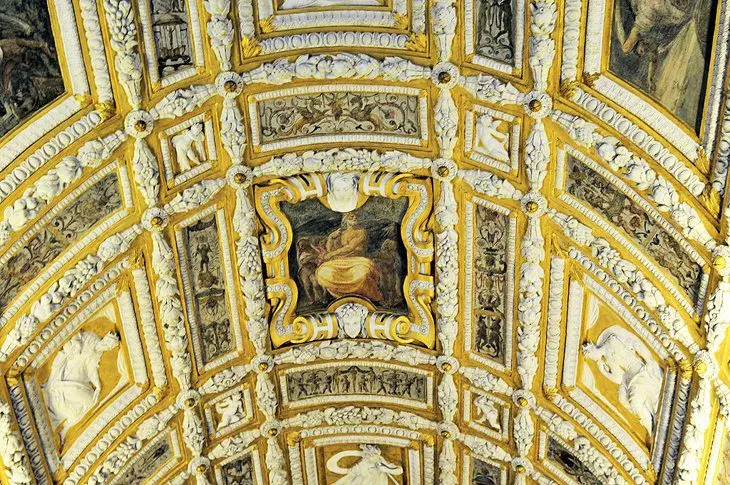
The Giants Staircase in the courtyard may be impressive for its size, but for impact, nothing here can beat the magnificent main and side staircases of the Scala d’Oro, the Stairs of Gold. Named for their rich gold decoration, these lead from the Loggia on the first floor (remember that in Italy the first floor is up one story from the ground floor) to the second floor and thence to the offices and reception rooms on the third floor.
In the days of the Republic, only members of the Council and the Doge’s guests of honor were allowed to use them. The staircase was probably begun by Sansovino in 1583 and completed by Scarpagnino around 1550.
Sala del Collegio and Sala del Senato
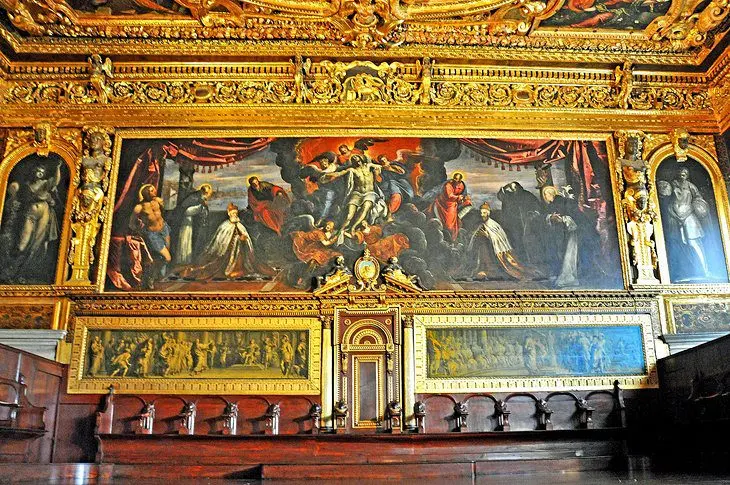
Considered by many to be the most beautiful room in the whole palace, Sala del Collegio is where the Collegio – the Cabinet – met under the chairmanship of the Doge, and where the Republic received its most important visitors. It is especially harmonious, with a unity of its decorations that is missing in some other state rooms in the palace.
Over the Doge’s throne is the large 1578 Veronese painting showing the Doge giving thanks for victory over the Turks in the crucial Battle of Lepanto. The outstanding ceiling has several more excellent Veronese paintings symbolizing Venice’s grand ideals, and the wall-paintings are by Tintoretto or his pupils.
Three other notable rooms are among this group of third-floor council chambers. The adjacent Sala dell’Anticollegio was a waiting-room for foreign delegations, with paintings by Tintoretto, Paolo Veronese, and Jacopo Bassano. Napoleon took Veronese’s famous Rape of Europa to Paris, but it was later returned.
The Senate met in the Sala del Senato, a sumptuous room with beautiful ceiling panels, to make policy guidelines and decisions on peace and war. The name of the Sala delle Quattro Porte refers to its four doors, each surrounded by rare marble and capped by sculptures. The room was designed by Andrea Palladio, and the ceiling and frescoes are from the studio of Tintoretto. Paintings are by Titian and Tiepolo.
Sala del Consiglio dei Dieci
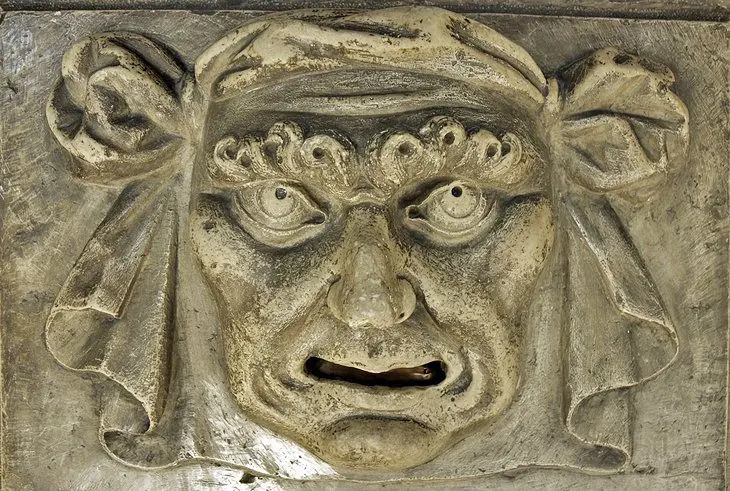
Adjoining the Sala delle Quattro Porte is a group of chambers, these showing another side of the inner workings of the Venetian Republic. The Council of Ten, which sat in the Sala del Consiglio dei Dieci, was the secret state court, in charge of the secret police and with control over every aspect of public and private life.
There was no appeal against their judgment. The room is elegant, with wood paneling, gilding, and paintings that include Veronese’s Jupiter Hurling Thunderbolts against the Vices and Juno offering the Ducal Crown to Venice.
Next to the door in the Sala della Bussola, where those summoned to appear before the Council of Ten waited to be examined, is a Bocca di Leone (lion’s mouth). These figures have an open slot for a mouth, where denunciations could be dropped in secret. The inquisitors, who met in the Sale dei Inquisitori were the examining magistrates. It was their task to interrogate offenders, if necessary with the aid of “inducements” to encourage confessions. The picture in the middle of the ceiling is Tintoretto’s Return of the Prodigal Son.
Doge’s Palace Apartments
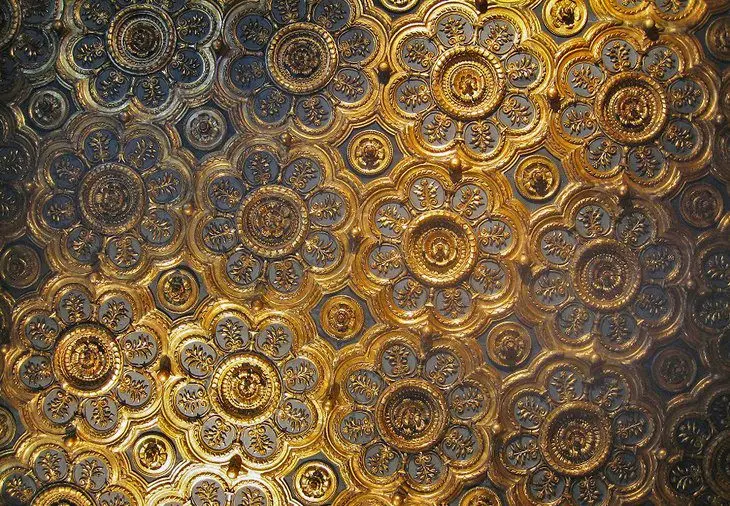
These rooms on the second floor of the east wing are surprisingly small. Each Doge furnished his apartments himself, and Napoleon made off with what was left, but even scantly furnished, the apartments are interesting for their art and décor. The most elaborate is the Sala degli Scarletti with a carved ceiling; a 1501 fireplace by Antonio and Tullio Lombardo; and two frescoed lunettes, one by Titian.
In the Sala dello Scrutinio, you’ll see Tintoretto’s The Conquest of Zara, and the Sala Erizzo has a 16th-century ceiling and marble and stucco chimneypiece. In a small picture gallery at the back of the suite are works by Giovanni Bellini, Boccaccio Boccaccino, Tiepolo, and Tintoretto, as well as some painted wood panels of demons by Hieronymus Bosch.
Prigioni (Prisons)
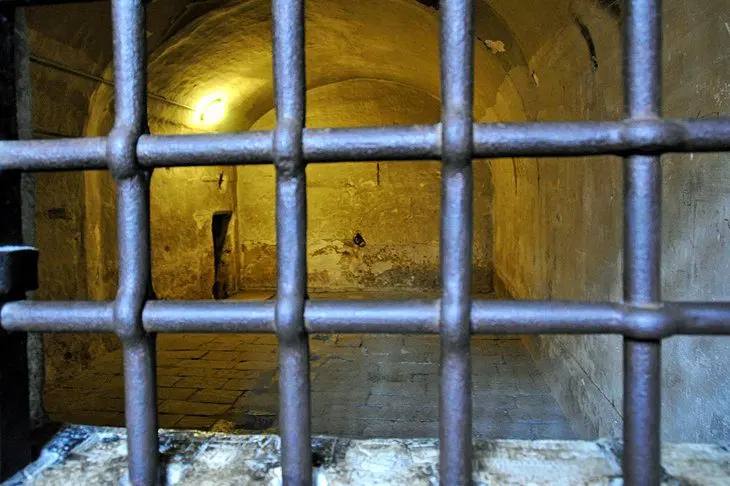
Regular public admission to the palace does not include the infamous prison cells where Casanova made his legendary and daring escape in 1755. But several private tours take small groups through the dank and dimly lit underground cells in the depths of the pozzi (wells) and into Casanova’s cell on the uppermost level.
Almost no one escaped, and especially feared were these piombi, or leads, low cells right under the lead roof that were like furnaces in summer. Access to the Prigioni is across the famous Bridge of Sighs, and after you’ve seen these grim and unlivable cells, you’ll sense the despair of those who crossed it.
An interesting sidelight to cell number 10 in the pozzi was discovered in a restoration in the 1980s. Under the dirt and lime was a painting by Riccardo Perucolo, a fresco painter imprisoned here during the Inquisition in 1549, accused of Lutheran heresy.
Armory
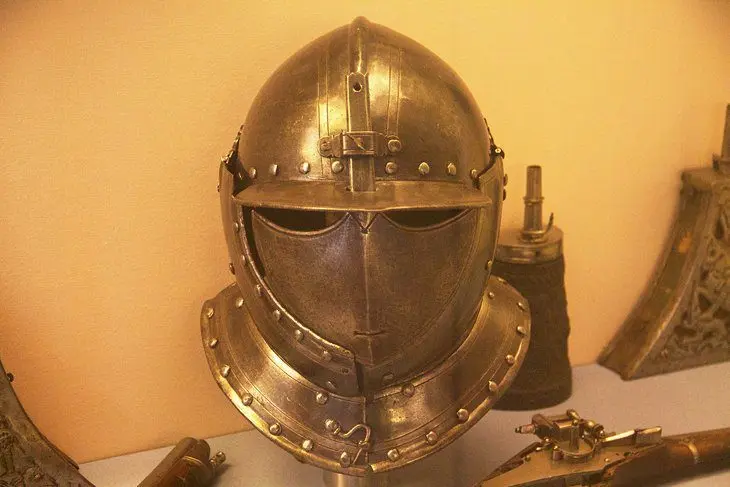
Visitors with an interest in Venice’s military history – and those with a taste for the bizarre – won’t want to miss the Armory, which began its collections in the days of the Council of Ten, as a storehouse for weapons of the not-insubstantial palace guards, and their back-up forces from the shipyards of the Arsenale.
The rooms display 15th- and 16th-century suits of armor, with swords, halberds, maces, and crossbows. To make no mistake about who these were meant to protect, many are inscribed or painted with CX – for Council of Ten. There are outstanding examples of firearms from the 16th and 17th centuries, torture apparatus, suits of armor for horses and armor used in tournaments, crossbows, swords, and Turkish artifacts taken at the battle of Lepanto in 1571.
Some of the exhibits are quite extraordinary, among them a “devil’s chest” that fired four hidden pistols (in case one missed?) when opened; a key that triggered a poisoned dart when turned; and a 20-barrel harquebus, predecessor of the machine gun. As if all this doesn’t testify enough to the brutal nature of Venetian life under the Doges, there’s a huge sword that was used for public executions held in St. Mark’s Square.
Where to Stay near the Doge’s Palace
We recommend these delightful hotels and guesthouses within easy reach of the Doge’s Palace:
- The 4-star luxury Hotel Moresco has uniquely decorated rooms and a private garden, which is rare in Venice. Breakfast is included, and guests are welcome to enjoy the hotel’s well-stocked library.
- The more moderately priced Hotel Antiche Figure occupies a 15th-century palazzo with traditional Venetian decor. The staff is especially accommodating, and the location is handy to the Santa Lucia train station.
- Only a few steps from the Doge’s Palace, Hotel Paganelli is set in a former convent, with elegant, traditionally furnished rooms. The attractive roof terrace has views across the Grand Canal, and breakfast is included.
- Just down the street from the San Zaccaria vaporetto stop and less than a five-minute walk from the Doge’s Palace, Hotel Campiello has small attractive rooms and an included breakfast buffet. Rates are modest for the prime location.
- On a quiet side street and close to the airport water bus stop, the low-moderate-priced Hotel San Moise is only five minutes from the Doge’s Palace. Rooms in the 3-star hotel are somewhat old fashioned, but comfortable, and the staff is very accommodating.
Tips and Tactics: How to Make the Most of Your Visit to the Doge’s Palace
- Timing: This is one of the top attractions in the city, so expect to wait in line. The best times to arrive are early morning and around noon, when tour groups go to lunch. Alternatively, book one of the skip the line tours mentioned above.
- Comfort: Wear good walking shoes. It’s a big complex with many stairs and dark, uneven passageways if you take a tour to the prisons.
- Food and Drink: Cafés and restaurants are all around St. Mark’s Square and along the Grand Canal, only a few steps from the Doge’s Palace.
Getting to the Doge’s Palace
- Take a vaporetto, Venice’s floating transit system, to San Marco or San Zaccaria stops, the closest to the Doges’ Palace. Street signs throughout the city point to San Marco.
Address
- Piazzetta San Marco, Venice
- http://palazzoducale.visitmuve.it/en/home/
